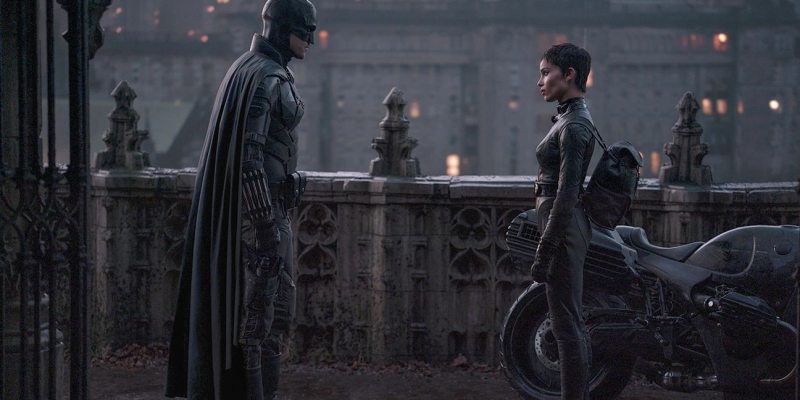This discussion of the “definitive” Batman contains some spoilers for The Batman.
A surprising amount of the early coverage of The Batman has leaned on the idea that it offers the “definitive” take on the Caped Crusader.
Director Matt Reeves has argued that he wanted to tell “a definitive Batman story” and explained that he needed the freedom to “do the definitive Batman movie.” Reviews suggest that critics agree. Matt Neglia, owner and editor of Next Best Picture, called the movie “the definitive Batman film.” Ryan McQuade at AwardsWatch argued that the film offered “the definitive take” on the Dark Knight. To be fair, the hint is in the title. It is The Batman, after all. The definite article, you might say.
However, it’s difficult to see exactly how definitive The Batman is definitively. Indeed, for better and for worse, the film assumes the audience’s existing familiarity with both the character and his world. More than any previous Batman movie, including sequels, The Batman assumes that the audience is coming to it with an understanding of what a Batman story looks like, who all these characters are, and how they relate to one another.
Notably, The Batman is surprisingly uninterested in the character of Bruce Wayne (Robert Pattinson). Perhaps reflecting fan complaints about the amount of time the character spent outside the cowl in the Christopher Nolan Dark Knight trilogy, Pattinson spends most of the film wearing the costume. Alfred (Andy Serkis) makes vague allusions to the financial problems at Wayne Enterprises, and characters talk about how reclusive Bruce is — but he’s not an active character.
To be clear, Bruce does have an arc in The Batman. The film contrasts him with the Riddler (Paul Dano) — another angry masked young man defined by his time as an orphan. Both Batman and the Riddler are vigilantes, who scrawl their dark thoughts in journals. The Riddler even grew up in Wayne Manor, after it was donated to the city. The Riddler serves as an effective cautionary tale for Bruce, a warning of what he might become if he ever stops believing that Gotham can be redeemed.

Similarly, the film plays out a miniature arc through Bruce’s relationship with the young son of Mayor Don Mitchell Jr. (Rupert Penry-Jones). Throughout the film, Bruce’s eye is drawn to the young boy scarred by the loss of his father. In The Batman, Thomas Wayne (Luke Roberts) was killed during a mayoral bid, to reinforce the parallel. Bruce learns that his vigilantism cannot be about enacting his own vengeance, but rather it should be about stopping other children from experiencing the loss that he did.
These are good and solid arcs, but they all assume a familiarity with Bruce Wayne as a character. They find a new prism through which Batman might be interrogated and examined, but they don’t feel particularly definitive. Pattinson is great in the central role, but he lacks the psychological complexity that Christian Bale brought to his take on the character, or the unique energy that made Michael Keaton’s interpretation so compelling, or even just Kevin Conroy’s versatility.
The same is true of the supporting characters. Paul Dano is great as the Riddler, but it’s hard to argue that he offers a definitive take on the character, particularly compared to Frank Gorshin. Zoë Kravitz is great as Selina Kyle, but it’s a performance that doesn’t seem as assured as Michelle Pfeiffer’s in Batman Returns or as nuanced as Anne Hathaway’s in The Dark Knight Rises. It doesn’t help that Kravitz is largely replaying the character arc that Hathaway nailed just a decade earlier.
Colin Farrell’s Penguin is perhaps the movie’s standout performance. However, even that exists in the shadow of Danny DeVito’s frankly demented turn in Batman Returns, what might be the most underrated supervillain performance. DeVito gave his blessing to Farrell, and Farrell’s stylized riff on the fowl-feathered fiend is likely to be the movie’s most memetic element. However, it’s difficult to describe it as definitive. Then again, maybe his HBO Max show will change that.

A lot of The Batman’s production design feels largely carried over from other Batman projects. Like Nolan’s Dark Knight trilogy, the film did some location shooting in Chicago, so certain shots feel very similar to Batman Begins. There are certain stylized production elements that lean heavily into the gothic aesthetic that defined Anton Furst and Bo Welch’s design of Gotham for Tim Burton’s Batman and Batman Returns.
Even narratively and thematically, The Batman treads familiar ground. The movie’s emphasis on voyeurism and surveillance hearkens back to the use of similar technology at the climax of The Dark Knight. At the climax of the movie, Gotham is ravaged by a synchronized terrorist attack that effectively destroys the civic government — a plot point The Dark Knight Rises lifted from comic book events like No Man’s Land. The Batman is not so much a distillation of Batman as a smorgasbord.
There is, to be clear, nothing wrong with this. The Batman is an enjoyable movie that is deservedly garnering great reviews. However, its strength doesn’t derive from offering a “definitive” take on the Caped Crusader. Part of the appeal of the character is that there probably is no single definitive take on the superhero. Batman is a broad enough archetype that he can support a wide variety of interpretations, each standing apart. The Lego Batman is as valid as The Batman.

The Batman works not because it is definitive, but because it is distinctive. Reeves takes many of these familiar elements, mixes and matches them in interesting ways, and makes something that stands quite apart from what came before. He blends his own interests and fascinations — particularly 1970s cinema — to create something different from the glut of superhero projects released to cinemas in recent years. It is a distinctively artisanal blockbuster project.
In many ways, The Batman is proof of Roger Ebert’s classic argument that “it’s not what a movie’s about(;) it’s how it is about it.” (It is also, perhaps, a demonstration of Ebert’s other contention that “no good movie is too long.”) The film is exceptionally well made, particularly in the context of a studio system that has grown increasingly conservative. Reeves trusts his collaborators to put their own stamp on the movie, and he fashions it into a cohesive and compelling whole.
Director of photography Greig Fraser allows rich bursts of color — deep reds and strong golds — to bleed into the darkness, giving the film a strong visual palette. Composer Michael Giacchino composes a stirring orchestral score that frequently draws attention to itself. Craig Henighan’s sound design does a lot to add to the rich texture of the movie and is a large part of how the movie manages to feel so visceral while still retaining a PG-13 rating.

These technical departments work together in ways that enrich the subtext of the movie. The Batman is a meditation on the superhero as an archetype, as a successor to the cowboy or the gangster in American popular consciousness. This connection is largely made aurally. Critics have noted Giacchino’s theme has “a spaghetti western twang,” and there are several points where it sounds like Batman is wearing spurs. It’s a wonderful illustration of storytelling through production.
The result is a blockbuster that feels more vivid than many contemporary superhero films. Unlike a lot of the recent Marvel Studios films, it has a distinct visual and aural identity. In many ways, this feels like what Marvel Studios half-heartedly attempted with Chloé Zhao on Eternals, which turned into a whole argument about auteurship in studio filmmaking. Eternals often felt like watching an argument between a director and a studio in real time, the resulting movie a compromise.
In contrast, like The Suicide Squad and Peacemaker before it, The Batman demonstrates the potential when a project like this is entrusted to a creative team given the freedom and authority to put their own stamp on the material. If the future of blockbuster cinema is to be dominated by these pieces of familiar intellectual property, classic characters and concepts replayed and recycled, let’s hope that at least some of them dare to be as distinctive as The Batman.
